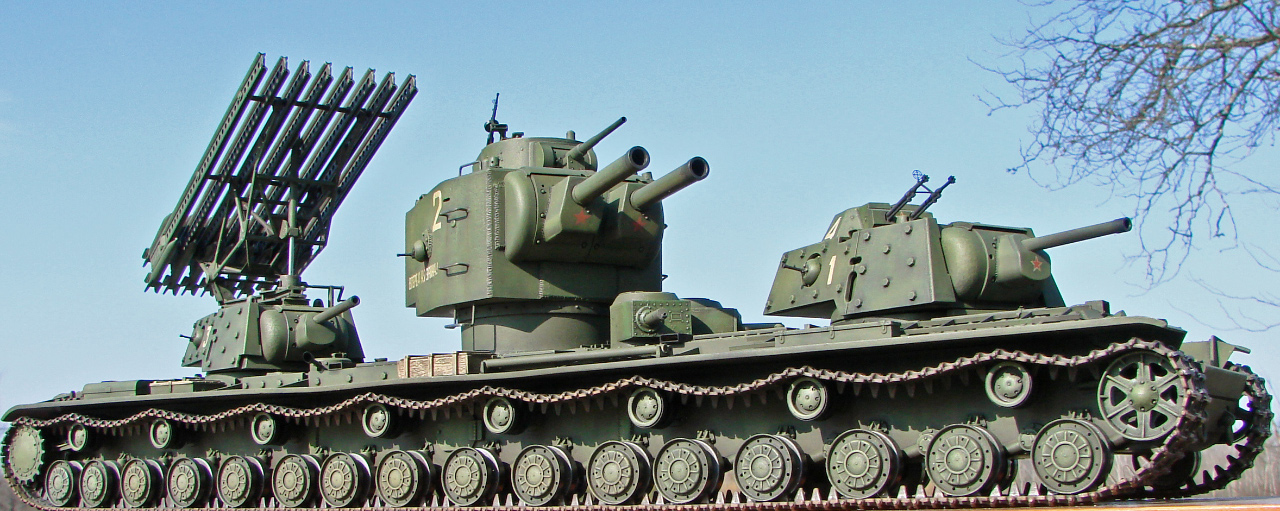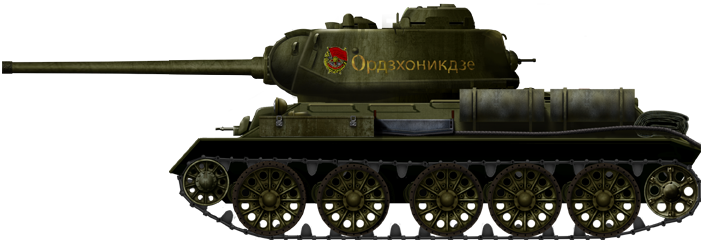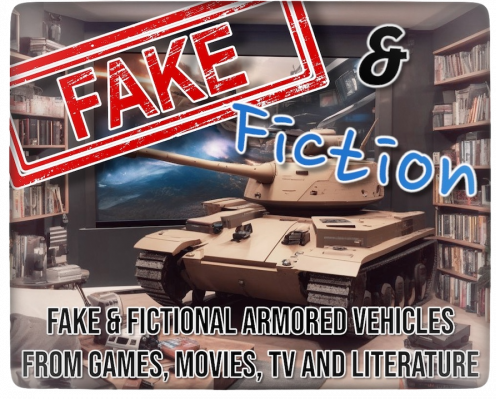Fake and Fictional Tanks and Armored Vehicles from Various Media
Fake
- ‘Czołg Ciężki Polski’ Markowskiego (Fake Tank)
- 59-Patton (Fake Tank)
- Batignolles-Châtillon Bourrasque (Fake Tank)
- Caernarvon ‘Action X’ (Fake Tank)
- Conqueror Gun Carriage (GC) (Fake Tank)
- CP Armoured Tractor (Fake Tank)
- E 100 Ausf.B (Henschelturm or Rinaldi’s Turret) (Fake Tank)
- FV215b (Fake Tank)
- Geschützwagen E 100 (Fake Tank)
- Jagdpanzer E 100 (Fake Tank)
- K-1 Krushchev (Fake Tank)
- K-91 (World of Tanks Fake Version)
- KV-VI (Fake Tank)
- Light Tank M3A3 with Mortar (Fake Tank)
- Lorraine 50t (Fake Tank)
- M-20UP1 (Fake Tank)
- Panhard EBR 105 (Fake Tank)
- Panther II mit 8.8 cm KwK 43 L/71 (Fake Tank)
- Polnischer Panzerkampfwagen T-39 (Fake Tank)
- Progetto M35 Mod. 46 (Fake Tank)
- Projet Tigre (April Fools Fake Tank)
- PZInż. 126 (Fake Tank)
- Soviet “Turtle” Tank (Fake Tank)
- T-26s with Kremlin Armory Cannons (April Fools Fake Tank)
- T-34-85-I (Fake Tank)
- T-34(r) mit 8.8cm (Fake Tank)
- T-34/SU-76 Hybrid (Fake Tank)
- T25 AT (Fake Tank)
- Tas rohamlöveg (Fake Tank)
- Twin-Turret BT Tank “BT-4” or “BT-VT” (Fake Tank)
- Type T-34 (Fake Tank)
Fictional
- Armored Assault Tank (AAT) (Fictional Tank)
- Army Surplus Special (Fictional Tank)
- David-class Mobile Combat Suit (Fictional Tank)
- H.G. Wells’ Land Ironclads (Fictional Tank)
- Hatay Heavy Tank (Fictional Tank)
- Macharius Heavy Tank (Fictional Tank)
- Tankenstein (Fictional Tank)
- Tanks from The Shape of Things to Come (Fictional Tank)
- Tanks in Fullmetal Alchemist (Fictional Tank)
- Vickers’ Snail (Fictional Tank)
- Walmington-on-Sea APC (Fictional Tank)
Props
Even before the dawn of the first tank, human imagination spawned armored vehicles in various forms. Among the first to dream up the precursors of current AFVs were Albert Robida, the French illustrator who drew armored vehicles in 1883, and H.G. Wells with his short story “The Land Ironclads”, published in 1903. These can be counted among the first tank concepts, but also as some of the first fictional tank designs conceived and they would not be the last. As tanks started to become more prominent on the battlefields, they started to appear on the big screen and to a wider audience as well.

The big screen, propaganda, TV shows, video games, and books, would not only show real tanks, but also fictional and even fake vehicles. While seemingly having the same meaning, one can make a distinction between the terms fake and fiction. This difference in meaning, while perhaps small, does bring certain consequences to how vehicles are classified. While every fake vehicle is technically a fictional vehicle, not every fictional vehicle has to be counted as a fake vehicle.
In more recent years, the appearance of Artificial Intelligence (AI) has to be contented with as well. With creating a seemingly realistic vehicle as easy as typing a few words into a generator – the very image at the top of this page was created as such – the number of fake vehicles will only increase over time.
Note: This page is not intended to list every single fake or fictional tank ever conceived.

Tank Encyclopedia’s Stance
Since its conception, Tank Encyclopedia has always focussed on presenting the true history and hard facts about tanks, armored vehicles, and military vehicles as a whole. As a by-product, this necessitates a certain degree of coverage when it comes to the concept of ‘fake and fictional’ battle machines. Quoting Tank Encyclopedia’s Team Manager:
“I think there are plenty of other options to write articles about which I’d rather have than fake and fictional tanks. However, they are a thing, and, to differing degrees, they’ve played an important role in our conceptualisation of what a tank is”
– Gareth Lynn Montes, TE Team Manager.
To this end, Tank Encyclopedia takes it very much as our responsibility to educate, to firmly separate fact from fake and fiction, and present it to our readers as concisely and professionally as possible.
Between Fake…
Fake vehicles are vehicles that either intentionally or perhaps unintentionally have been fabricated to mislead people into believing that they are real historical vehicles or projects that have really been considered by one real-world faction or another. It is important to note that some vehicles may have initially been created as jokes or hypothetical what-if vehicles, but have over time managed to convince people they were real because they were so convincing.
An excellent example of an unintentional fake is the KV-VI, which started off as a scratch-built scale model and a joke post, which eventually morphed into a fake tank after photoshopped images of a supposed real KV-VI appeared on the internet. While the issue has mostly been resolved as a fake, the photoshopping of parade images convinced some that the KV-VI was an actual project.

Some unintentional vehicles may also have come from a misunderstanding in sourcing. This is exemplified by how Tank Encyclopedia once made the error with the T-34-85-I. The vehicle appeared on the website WWIIvehicles.com, where two source books were cross-referenced incorrectly. This gave the idea that, in 1943, the Soviets had made a T-34 tank mounting an IS-85 turret and came with a fake designation T-34-85-I. Eventually, Tank Encyclopedia made the first what-if illustration mistakenly presented as representing a real vehicle, and the T-34-85-I was popularized by accident.

Source: Tank Encyclopedia
Intentional fakes are perhaps the most problematic from a factual and historical point of view. These are fake vehicles that are made with the intention to mislead. The biggest culprit used to be the fairly innocent creations of those with access to Photoshop or other raster graphic editors. Users would often take historical images and doctor them to show a German Panzer V Panther in Chinese service or a Soviet T-34 fitted with an 8.8 cm KwK 36 gun from the Tiger I, to name just a few.
In recent years, the biggest producer of fake vehicles has been via video games, perhaps most notoriously via Wargaming, the publisher of World of Tanks (WoT). They have brought life to several fake vehicles, which, due to their start in the industry of using mostly real vehicles and prototypes, has blurred the lines when they started introducing fake vehicles. This in turn has confused players as Wargaming does not always clearly state that these fake vehicles are in fact fake. The issue, of course, is not adding fake vehicles to the game, as certain game aspects and a lack of historical projects almost demand this. Of course, Wargaming, or any other video game, has the right to add as many fake tanks to their game. The issue, from a historical point of view, is the lack of honesty in labeling them as inventions of the game developers. These only make the game more interesting because people are being misled that the developer has uncovered unique vehicles that nobody else has. World of Tanks has since stepped away from marketing itself as a completely realistic or historical tank game but still does not explicitly admit to making up vehicles.

Another topic which has created its fair share of fakes has been the modeling world. Among one of the most popular subjects in scale modeling is the so-called ‘what-if’ genre. The genre can range from planes to tanks and is not solely focused to a single nation. However, the most popular sub-genre o has been Nazi Germany. Vehicles such as the E-100 have had many re-imaginations through the eyes of scale modelers through so-called scratch-builds or kit conversions.
Naturally, scale modeling companies have attempted to satiate this market through their own kits. An example is the E-100 Super Heavy Tank kit by the Chinese company Trumpeter. This kit started its life as a kit conversion from Michael Rinaldi, by converting a Dragon Models E-100 using the Maus turret, but replacing the turret with a what-if design of his own. This design was later copied without consent by Trumpterer, which then marketed it as the E-100. The issue with these conversions tends to be more the vehicles used rather than them intentionally misleading enthusiasts. The German E-series has always been a bit of a greyzone with a lot of actual interesting and intriguing concepts. But due to its relative obscurity, it is not always easy to distinguish which models were based on real designs, used a little bit of imagination, or completely made up.

…And Fiction
Fictional tanks are much less problematic from a historical point of view, as, overall, the vehicles have been made up and nobody pretends otherwise. There is always a gray zone between fake and fictional vehicles, where some fictional vehicles may just be on the edge of turning into a vehicle mistaken for a real project. Overall, fictional vehicles are usually quite clearly fictional because of the setting they are presented in or because they are so ludicrous that it would be hard to believe they would have ever been real (although one might have argued the same for the KV-VI).

Movies, television shows, video games, and literature have all created fictional tanks. There are completely fictional designs with no resemblance to historical tanks in all but shape and general concept, like the tanks from the table-top miniatures game Warhammer 40K or Activision-Blizzard’s Starcraft video game series. But there are also fictional tanks from media that base their design heavily on existing tanks but take place in fictional settings, such as the ‘Hatay Tank’ from the movie Indiana Jones: The Last Crusade (1981), as well as examples from anime, such as those from Fullmetal Alchemist or Valkyria Chronicles.

Source: FMA: Brotherhood Anime
These latter types of fictional tanks are usually the vehicles that are part of the gray zone between fake and fiction, with seemingly realistic portrayals of fictional tanks that could be confused as real tanks by an unknowing audience. While a simple Google search would usually point out that the vehicles are indeed fake, not everyone would have the interest to do so. The Hatay heavy tank is one of these vehicles that resembles an actual tank so closely that it could be mistaken as an actual design, save for the fictional context it was placed in.

The tank that featured in Universal Pictures’ Fast & Furious 6 (2013) is a fairly good example, as a Chieftain was converted into a fictional tank and could trick audiences into thinking that the vehicle they see is, in fact, an actual vehicle. This is not necessarily problematic, as a Google search would remedy this or, more likely, the viewers simply are not bothered if it is a real or fake tank to begin with in a franchise that is already so over the top. What makes these vehicles more of a fictional nature is that the design concepts of these vehicles tend to be quite unrealistic. This separates these vehicles from, for example, prop tanks, which are effectively tanks or other vehicles disguised to look like other tanks.

Prop Tanks
A loosely connected topic is that of Prop tanks used in movies. For one reason or another, the real version of a vehicle is not always available. In the case of representing older vehicles, there simply might not be any left to use, or they exist only as museum pieces that do not run/are too historically precious to be run. For modern vehicles, it may just be that a respective military does not want to lend its armor to a movie production, but this is not always the case.
Regardless, for whatever reason a real tank is not available, production teams will often build ‘their tank’ on the hull of an existing vehicle. The most well-known examples of this are the ‘dressed-up’ T-34s used in movies such as Kelly’s Heroes (1970) and Saving Private Ryan (1999) to represent Tigers.
More recently, production companies – when looking for an Abrams for example – often turn to the old British Centurion or Chieftain. An example of this would be the ‘Abrams’ tanks seen in Hulk (2003), which are actually dressed-up Chieftains. When an older tank is not available in large enough numbers, more modern or plentiful tanks are used, without any modification. This can result in some comically bad looking vehicles. Examples of this include the ‘King Tigers’ of the Battle of the Bulge (1965), where Spanish Army M47 Patton IIs were simply painted gray with a balkenkreuz applied to the side. Another example is Patton (1970), where M48 Patton IIIs simply painted beige were used to represent German armor.

Artificial Intelligence (AI)
In the 2020s, a new ‘menace’ emerged for armored vehicle historians to contend with; Artificial Intelligence (AI). This has, perhaps, become the easiest and most accessible way to produce a fake tank design, with many free-use web browser sites and smartphone apps. With its use by YouTubers and other content creators, the use of AI generation will only grow, as will the number of fake vehicles released to the internet.
Simply typing word prompts into a generator can create a realistic-looking vehicle. With choices of filter and background, etc, it is easy to place said fake tank into a ‘realistic’ historical setting. As an example, we even used it to create the title banner of this page.

Conclusion
While not always part of tank history proper, fake and fictional tanks encapsulate the imagination of what a tank is. They prove that the existence of the tank has left an unmistakable mark on humanity, whether on the real battlefields of past and present, or the virtual battlefields of the screen and console. As long as the concept of a tank exists, there will be fake and fictional adaptations to follow. Undoubtedly, many more adaptations and imaginations of the tank will appear in the future.
While Tank Encyclopedia prefers to cover real tanks, these fake and fictional vehicles will be covered as well. After all, an encyclopedia should strive to cover everything regarding the subject.


4 replies on “Fake & Fictional”
Good idea to create this section. I would like to add that you forgot some articles, like the E 100 Ausf. B (Henschelturm or Rinaldi’s turret), Lorraine 50t, Geschützwagen E 100…
Sorted, thank you.
– TE Staff
I don’t know if anyone has ever seen the photoshop photo of a T-34 with StuG III upper hull attached.That is one of the biggest fake photos I know of.
I think you might find the Warthunder Wiki very helpful in finding ideas for new articles and illustrations.